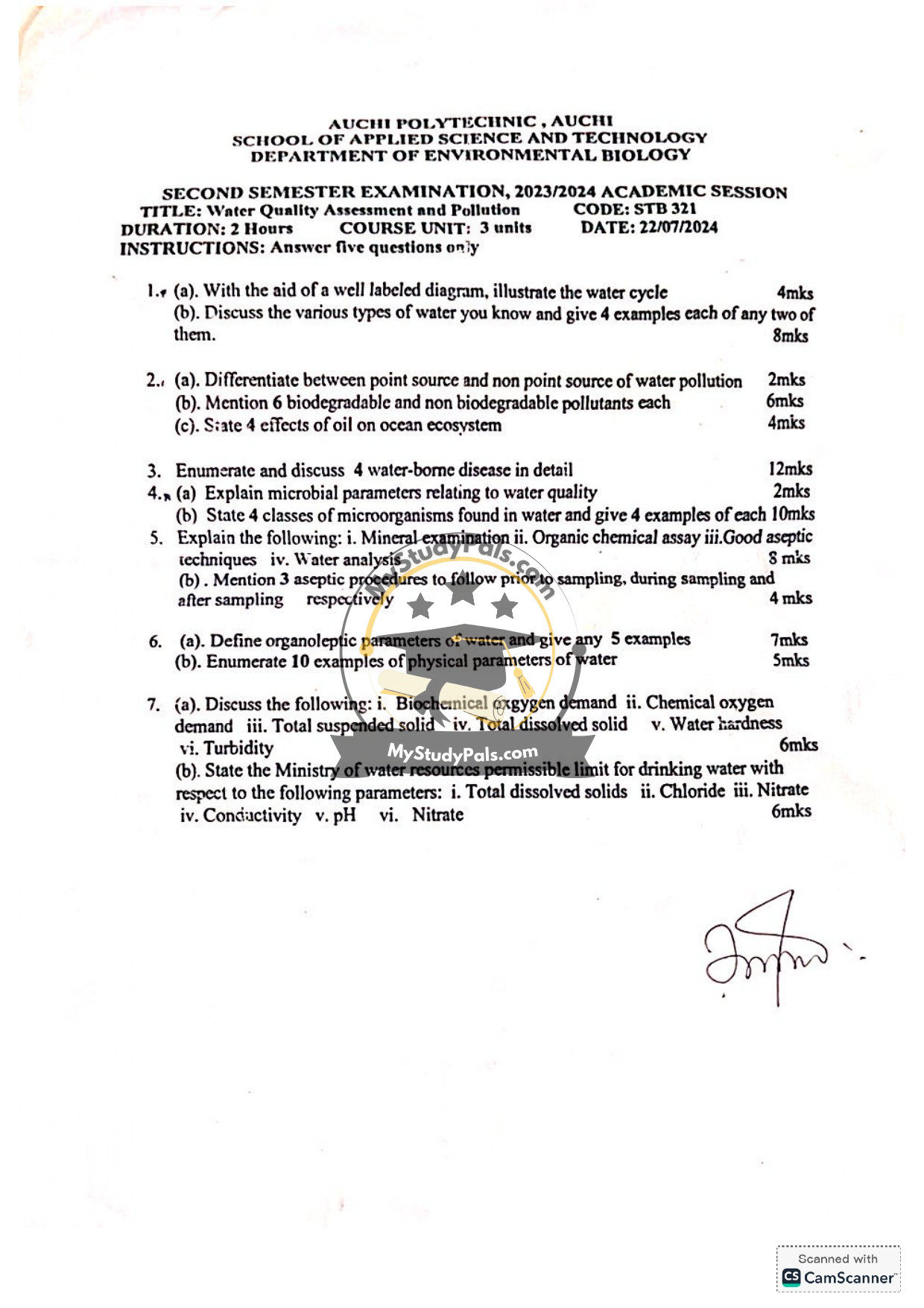ANWSER
Question 1:
(a) The water cycle (also known as the hydrological cycle) includes processes such as evaporation, condensation, precipitation, infiltration, runoff, and transpiration.
A well-labeled diagram would show:
- Evaporation from water bodies
- Condensation forming clouds
- Precipitation (rain, snow)
- Runoff into rivers and lakes
- Infiltration into the ground
- Transpiration from plants
(b) Types of water and examples:
- Surface water: Rivers (e.g., River Niger), lakes (e.g., Lake Chad), ponds, streams
- Groundwater: Boreholes, aquifers, wells, springs
- Rainwater: Rooftop collected rain, stormwater
- Wastewater: Domestic sewage, industrial effluent, agricultural runoff
- Treated water: Chlorinated water, distilled water, RO water, UV treated water
Question 2:
(a)
- Point source pollution: Comes from a single, identifiable source (e.g., factory discharge pipe).
- Non-point source pollution: Comes from diffuse sources (e.g., runoff from agricultural land).
(b)
- Biodegradable pollutants: Sewage, food waste, paper, plant matter, agricultural waste, animal manure
- Non-biodegradable pollutants: Plastics, heavy metals, pesticides, glass, synthetic chemicals, motor oil
(c) Effects of oil on ocean ecosystem:
- Blocks sunlight, affecting photosynthesis
- Harms marine life through toxicity
- Destroys habitats like coral reefs and mangroves
- Disrupts the food chain
Question 3:
Enumerate and discuss 4 water-borne diseases:
- Cholera: Caused by Vibrio cholerae, transmitted through contaminated water, causes severe diarrhea.
- Typhoid: Caused by Salmonella typhi, spread via fecal-contaminated water, symptoms include fever and abdominal pain.
- Dysentery: Caused by Shigella or Entamoeba histolytica, leads to bloody diarrhea.
- Hepatitis A: Viral disease spread through contaminated water, affects the liver, symptoms include jaundice and fatigue.
Question 4:
(a) Microbial parameters: Indicators of pathogenic microorganisms such as total coliforms, fecal coliforms, E. coli, and enterococci. These indicate fecal contamination and waterborne disease risk.
(b)
Classes of microorganisms in water and examples:
- Bacteria: E. coli, Salmonella, Vibrio, Shigella
- Viruses: Hepatitis A, Norovirus, Rotavirus, Enterovirus
- Protozoa: Giardia, Cryptosporidium, Entamoeba, Balantidium
- Fungi: Aspergillus, Candida, Fusarium, Penicillium
Question 5:
(a)
i. Mineral examination: Identifies minerals (e.g., calcium, magnesium) present in water.
ii. Organic chemical assay: Tests for organic pollutants like pesticides, solvents.
iii. Good aseptic techniques: Sterilized equipment, avoiding contamination, using gloves.
iv. Water analysis: Involves testing physical, chemical, and biological properties of water.
(b) Aseptic procedures:
- Prior to sampling: Use sterilized containers
- During sampling: Avoid touching the inside of containers, collect midstream
- After sampling: Label and store samples properly, refrigerate if needed
Question 6:
(a) Organoleptic parameters: Sensory attributes of water including:
- Taste
- Odor
- Color
- Turbidity
- Temperature
(b) Physical parameters of water (10 examples):
- Temperature
- Color
- Odor
- Taste
- Turbidity
- Conductivity
- Total dissolved solids (TDS)
- pH
- Salinity
- Hardness
Question 7:
(a)
i. Biochemical Oxygen Demand (BOD): Measures organic pollution by assessing oxygen required for microbial decomposition.
ii. Chemical Oxygen Demand (COD): Total oxygen required to oxidize organic/inorganic matter.
iii. Total Suspended Solids (TSS): Solids suspended in water, affects clarity.
iv. Total Dissolved Solids (TDS): Sum of all dissolved ions; impacts water taste.
v. Water Hardness: Concentration of calcium and magnesium ions.
vi. Turbidity: Measure of cloudiness due to suspended particles.
(b) Permissible limits by Ministry of Water Resources (approximate, may vary):
- Total dissolved solids (TDS): ≤ 500 mg/L
- Chloride: ≤ 250 mg/L
- Nitrate: ≤ 50 mg/L
- Conductivity: ≤ 1000 µS/cm
- pH: 6.5–8.5
- Nitrate: Repeated for emphasis, ≤ 50 mg/L


